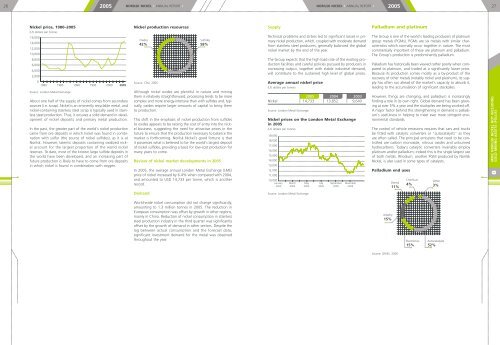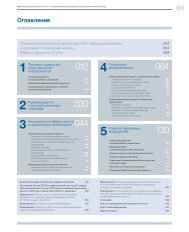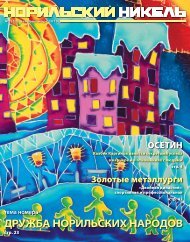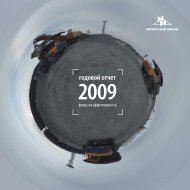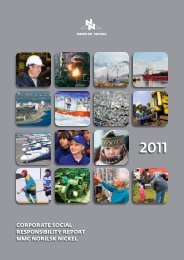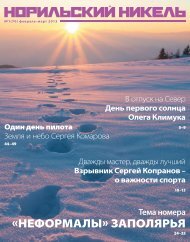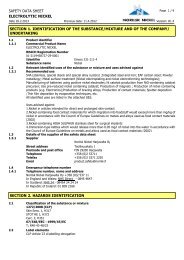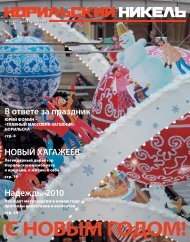Untitled - PRIME Gold
Untitled - PRIME Gold
Untitled - PRIME Gold
- No tags were found...
Create successful ePaper yourself
Turn your PDF publications into a flip-book with our unique Google optimized e-Paper software.
26 2005 NORILSK NICKEL • ANNUAL REPORT •NORILSK NICKEL • ANNUAL REPORT •200527Nickel price, 1980–2005(US dollars per tonne)Source: London Metal ExchangeAbout one half of the supply of nickel comes from secondarysources (i.e. scrap). Nickel is an eminently recyclable metal, andnickel-containing stainless steel scrap is typically used in stainlesssteel production. Thus, it ensures a solid demand in developmentof nickel deposits and primary metal production.In the past, the greater part of the world's nickel productioncame from ore deposits in which nickel was found in combinationwith sulfur (the source of nickel sulfides), as it is atNorilsk. However, lateritic deposits containing oxidized nickelaccount for the largest proportion of the world nickelreserves. To date, most of the known large sulfide deposits inthe world have been developed, and an increasing part offuture production is likely to have to come from ore depositsin which nickel is found in combination with oxygen.Nickel production resourcesSource: CRU, 2005Although nickel oxides are plentiful in nature and miningthem is relatively straightforward, processing tends to be morecomplex and more energy-intensive than with sulfides and, typically,oxides require larger amounts of capital to bring themto production.This shift in the emphasis of nickel production from sulfidesto oxides appears to be raising the cost of entry into the nickelbusiness, suggesting the need for attractive prices in thefuture to ensure that the production necessary to balance themarket is forthcoming. Norilsk Nickel's good fortune is thatit possesses what is believed to be the world's largest depositof nickel sulfides, providing a basis for low-cost production formany years to come.Review of nickel market developments in 2005In 2005, the average annual London Metal Exchange (LME)price of nickel increased by 6.4% when compared with 2004,and amounted to USD 14,733 per tonne, which is anotherrecord.SupplyTechnical problems and strikes led to significant losses in primarynickel production, which, coupled with moderate demandfrom stainless steel producers, generally balanced the globalnickel market by the end of the year.The Group expects that the high load rate of the existing productionfacilities and careful policies pursued by producers inincreasing output, together with stable industrial demand,will contribute to the sustained high level of global prices.Average annual nickel price(US dollars per tonne)2005 2004 2003Nickel 14,733 13,852 9,640Source: London Metal ExchangeNickel prices on the London Metal Exchangein 2005(US dollars per tonne)Palladium and platinumThe Group is one of the world's leading producers of platinumgroup metals (PGMs). PGMs are six metals with similar characteristicswhich normally occur together in nature. The mostcommercially important of these are platinum and palladium.The Group's production is predominantly palladium.Palladium has historically been viewed rather poorly when comparedto platinum, and traded at a significantly lower price.Because its production comes mostly as a by-product of therecovery of other metals (notably nickel and platinum), its supplyhas often run ahead of the market's capacity to absorb it,leading to the accumulation of significant stockpiles.However, things are changing, and palladium is increasinglyfinding a role in its own right. Global demand has been growingat over 5% a year and the stockpiles are being worked off.A major factor behind this strengthening in demand is palladium'susefulness in helping to meet ever more stringent environmentalstandards.The control of vehicle emissions requires that cars and trucksbe fitted with catalytic converters or "autocatalysts" as theyare often called. The principal emissions that need to be controlledare carbon monoxide, nitrous oxides and unburnedhydrocarbons. Today's catalytic converters invariably employplatinum and/or palladium; indeed this is the single largest useof both metals. Rhodium, another PGM produced by NorilskNickel, is also used in some types of catalysts.Palladium end usesMMC NORILSK NICKEL NOT INCLUDINGGOLD MINING ASSETS (POLUS)8DemandSource: London Metal ExchangeWorld-wide nickel consumption did not change significantly,amounting to 1.3 million tonnes in 2005. The reduction inEuropean consumption was offset by growth in other regions,mainly in China. Reduction of nickel consumption in stainlesssteel production industry in the third quarter was significantlyoffset by the growth of demand in other sectors. Despite thelag between actual consumption and the forecast data,significant investment demand for the metal was observedthroughout the year.Source: GFMS, 2005


